








PUBLISHER
James R. Baker
GENERAL MANAGER
John Rusnak
EXECUTIVE EDITOR
Andy Walgamott
EDITOR
Chris Cocoles
CONTRIBUTORS
Mark Fong, Scott Haugen, Tiffany Haugen, Cal Kellogg, Todd Kline, Bill Schaefer
SALES MANAGER
Paul Yarnold
ACCOUNT EXECUTIVES
Colleen Chittick, Mike Smith
DESIGNER
Lesley-Anne Slisko-Cooper
PRODUCTION ASSISTANT
Kelly Baker
DIGITAL STRATEGIST
Jon Hines
ADMINISTRATIVE ASSISTANT
Katie Aumann
INFORMATION SERVICES MANAGER
Lois Sanborn
ADVERTISING INQUIRIES
ads@calsportsmanmag.com

CORRESPONDENCE
Email ccocoles@media-inc.com
Twitter @CalSportsMan
Facebook.com/californiasportsmanmagazine

ON THE COVER
Scott Haugen is gearing up for gobblers. California’s spring turkey season opens on March 25 and continues through April 30.
(SCOTT HAUGEN)MEDIA INC PUBLISHING GROUP 941 Powell Ave SW, Suite 120 Renton, WA 98057
(800) 332-1736 • Fax (206) 382-9437


media@media-inc.com
www.mediaindexpublishing.com

Our correspondent Mark Fong picked the brain of one of Northern California’s best striped bass guides, Oakley-based Jeff Soo Hoo, who has been targeting linesides on the Sacramento-San Joaquin Delta for 20 years. Soo Hoo shares where and how to target ’em, as well as the joys of catching these tasty treats on light tackle.
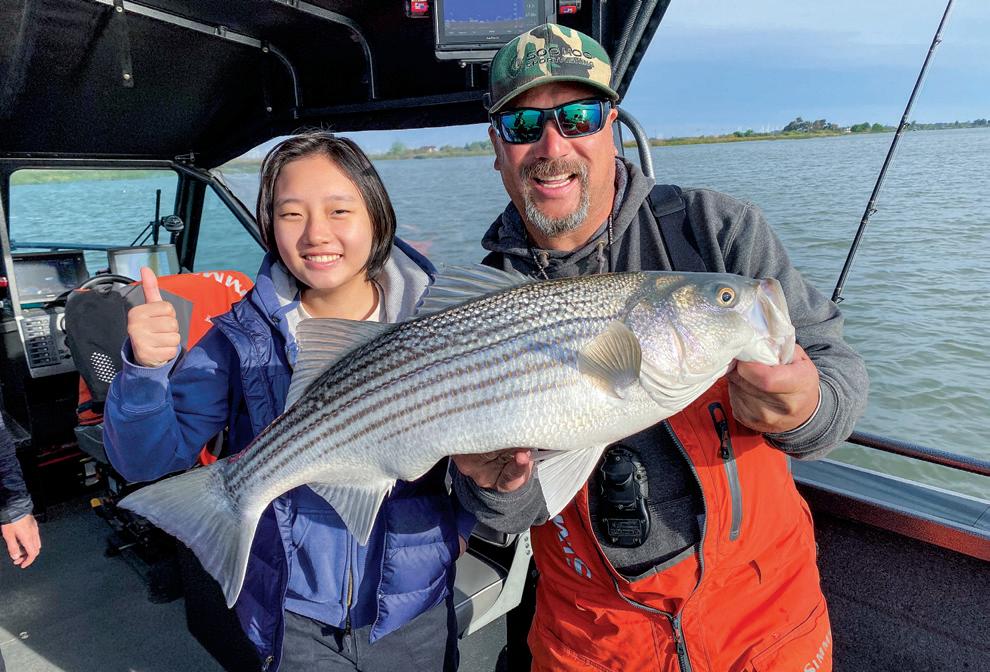
23 GO CRAZY FOR KOKANEE
They may not be the biggest fish in the pond, but kokanee provide anglers with feisty fights and delicious table fare. Guide Cal Kellogg loves targeting these landlocked sockeye salmon that swim in several lakes throughout the Sierra foothills and beyond. Kellogg breaks down tactics and gear choices to enjoy a fun day on the water.
33 BASSER’S PRESPAWN PRIMER
Even as spring beckons, Southland bass anglers sometimes are reluctant to fish for bass in prespawn mode. But don’t tell that to Capt. Bill Schaefer, who doesn’t pass up the chance to test himself and take on the fish. Warmer March weather could kick-start the spawning process, so check out Bill’s tips and get on out there for largemouth!
49 SCORING TIMBER TOMS
Some of Scott Haugen’s best spring turkey hunting occurs in heavy timber, home to very challenging and super-wary birds. Thanks to trail cameras and a lot of his own time spent in the woods, Haugen’s figured out methods for bagging these toms, and with California’s spring gobbler season opening March 25, he shares that mix of mobility, patience and simple calling that should put you in the thick of things. Meanwhile, his wife Tiffany’s corned turkey recipe rounds out the Haugen’s From Field to Fire feature.


Ithink the last fishing contest I had ever participated in – at least an official “tournament” with anyone keeping tabs on catches – was my Crestmoor Elementary School class that went on an end-of-theschool-year outing to my childhood fishin’ hole, Lake Merced in San Francisco.
Decades later, I entered another contest early last month, the first of multiple NorCal Trout Challenge events hosted by Angler’s Press at another of my old fishing stomping grounds, San Pablo Reservoir across San Francisco Bay in Contra Costa County. Needless to say: Both of the competitions didn’t turn out great if you count weighing in trout and having a puncher’s chance at a prize. I got skunked both as a little kid and a middle-aged man!
But I can truthfully say I had fun both times – futile as they proved to be. But congratulations to angler Kevin Garcia, whose 3.66-pound rainbow proved to be the winning fish. I don’t feel too bad, as out of the 125 of us who entered that Feb. 4 event, Garcia’s trout was one of just 11 fish that were weighed in at the Angler’s Press table located at the San Pablo Reservoir’s marina (two youth anglers also won prizes).

While there were a lot of boats out that morning of San Pablo’s opening weekend for 2023, most of us who chose to fish on the shore didn’t have much action. When my sister Charlene and I arrived at the parking lot around 7 a.m., I knew time would be of the essence. Rain was forecast for the Bay Area later that day, but with the NorCal Trout Challenge weigh-in open until early in the afternoon, we expected to stay dry most of the morning.
We did not.
And that was part of the problem that plagued us bank casters that morning. The heavy rainfall throughout this past winter turned the lake muddy and messy, not exactly great clarity for hungry rainbows looking for an easy meal.
As the chilly temperatures eventually sent Charlene back to the car, I kept throwing out different colors of PowerBait in faint hopes a rainbow would take it for a ride. But as I chatted up two ladies fishing next to me along a crowded stretch of shoreline – we struggled to find an open
spot near the parking lot – luck wasn’t on our side that day.
In the end we all got wet, thanks to a couple showers that swept through the area. At least it helped with the drought. After a couple hours of absolutely nothing, I did see my rod tip quickly snap forward. I excitedly grabbed the rod and tried to set the hook, but that was as good as it got for me. My PowerBait had been stolen, and while I at least had renewed hope for my next few casts, the optimism quickly faded. After about four hours of trying my luck, I was cold, wet and hungry for lunch.
I stopped by the Angler’s Press booth
and chatted up the organization’s vice president, Sheldon Bright (I also met Angler’s Press founder and CEO Vince Harris).
Bright and I talked about possibly working together down the line on projects – Angler’s Press is planning to run a sportsman’s show in the fall, so more on that at a later date – and he told me stories of past NorCal Trout Challenge events that also had slow fishing success

until the very last minute of weigh-ins. We also talked about old friends/colleagues in the business.

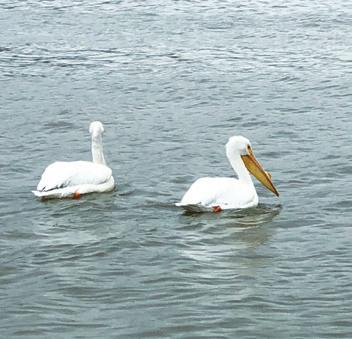
After we exchanged business cards and shook hands, I told Bright I’d try to head back down in the spring and possibly enter another round of the series of events (the next stop is Lake Amador on March 11, followed by April 8 at Collins Lake and May 6 at Pardee Lake). Sign up at anglerspress.com/events/norcal-troutanglers-challenge and you might have more luck than I did. But I think you’ll have fun either way. -Chris

 Cocoles
Cocoles

TIME

Docking and maneuvering your boat in high winds has never been so easy. Let the Joy Stick do it for you.




GPS position hold and heading hold is included.

8 and 99 Kicker Motors in stock. Call


We’re not ashamed to admit it: Todd Kline has the kind of life we wish we could experience. Kline’s a former professional surfer, a successful co-angler on the FLW Tour and a Southern California bass guide, plus he gets to travel the world as a commentator for the World Surf League’s telecasts. Todd has agreed to give us a peek on what he’s up to each month. For more on Todd or to book a guided fishing trip with him, check out toddklinefishing.com, and you can follow him on Instagram at @toddokrine. –The Editor
February was a very special month for me. I won the first Major League Fishing Toyota Series tournament of 2023, which was held on Lake Havasu. I was blessed with over 60 pounds of bass for the three-day tournament and $29,392 in winnings. (MAJOR LEAGUE FISHING)


On the water at Havasu for a day of competitive fishing. (MAJOR LEAGUE FISHING)

Here are a pair of day-two tourney fish from a 23-pound limit. My catch was anchored by a 7.2-pounder. (MAJOR LEAGUE FISHING)
Scale don’t lie! A fun winter day of bass fishing down in San Diego gave me a 36.53-pound five-fish haul.


(TODD KLINE)
A great day on the water that produced two fistfuls of lunkers wrapped up a memorable month of fishing! (TODD KLINE)
April 1 - June 4, 2023
kernrivervalley.com • facebook.com/LakeIsabellaFishingDerby
ENTER TO WIN! $250 Early Bird Drawing Deadline March 22, 2023

Sponsored by Fred Clark A Farmers Insurance Agency
32ND ANNUAL ISABELLA LAKE FISHING DERBY PREMIERE SPONSOR











ENTRY INFORMATION
Adult: $40 / Youth: $15


PRIZE OPPORTUNITIES
500 Tagged Trout Tag Values $20-$10,000
• Early bird registration deadline is Wednesday, March 22, 2023 by 5pm

• Online registration closes Saturday April 1, 2023 at 7am

• No entries will be accepted after 7am on Saturday April 1, 2023. No exceptions.
• Derby Headquarters: Chamber of Commerce is located at 6416 Lake Isabella Blvd., Lake Isabella, CA. 760-379-5236.






3-5 NorCal Boat, Sport and RV Show, Shasta District Fairgrounds, Anderson; norcalsportshow.com

4 Central Valley Anglers Team Trout Derby, Lake Camanche; centralvalleyanglerslodi.org
11 Blake Jones Trout Derby, Owens River and Pleasant Valley Reservoir, Bishop; bishopvisitor.com/event/ blake-jones-trout-derby
11 NorCal Trout Angler’s Trout Challenge, Lake Amador; anglerspress.com/events/norcal-trout-anglers-challenge
18-19 Junior wild turkey hunting dates
19 Last day of falconry rabbit and varying hare season
25 Spring wild turkey season opens
29-APRIL 2 Bart Hall Shows, Long Beach Convention Center; hallshows.com
1 Bullards Bar Reservoir Team Kokanee Derby; kokaneepower.org/derbies
1-2 SMUD Trout Derby, Rancho Seco Recreation Area; anglerspress.com/events/smud-trout-derby
1-2 Redding Sportsman’s Expo, Redding Civic Auditorium; reddingsportsmansexpo.com
1-JUNE 4 Isabella Lake Fishing Derby; kernrivervalley.com/ isabellalakefishingderby
7-8 Blue Lakes Trout Derby; thenarrowsresort.com
22-23 NorCal Guides and Sportsmen’s Association Striped Bass Derby, Sacramento River; ncgasa.org
29 Statewide general trout fishing season opener
29 Fish of the Month Derby, Gull Lake; 760-648-7539; gulllakemarina.com
29 Fishmas Day Derby, Tom’s Place Resort, Crowley Lake; 760-935-4239; tomsplaceresort.com
29 Mono Village’s Fishing Opener Derby, Upper Twin Lake, Bridgeport; 760-932-7071; monovillage.com
29 Monster Trout Contest, June Lake; (760) 648-7756; junelakeloop.org
For a list of upcoming bass tournaments, go to nrm.dfg.ca.gov/ FishingContests/default.aspx.
Drastically improve performance and steering of bow-mounted electric trolling motors with the LeeLock Magnum Skeg. The use of bow-mounted electric trolling motors for salmon trolling is a game changer. Not only does this skeg improve performance, it makes bow-mounted electric trolling motors much more efficient. Your batteries will run longer on a charge. The LeeLock Magnum Skeg can be a vital part of your trolling motor system!
The skeg is made of anodized 5052 aluminum. The size is 8 3/4 inches high by 10 inches wide and it’s 3/16 inch thick. The anodization keeps the aluminum from corroding in fresh- and saltwater. The LeeLock Magnum Skeg is available to fit most Minn Kota and MotorGuide (pictured) motors. It comes with clear PVC-coated stainless steel hose clamps. Call 360-380-1864 or write info@ leelock.com if you have any questions about fit.


This new tool from Leelock will allow you to measure your Dungeness crabs to determine which ones are legal to keep. Then use the Crab Cracker to crack them in half, separating the two clusters from the shell and guts.

The Crab Cracker has been designed so that it sits nicely on top of a 5-gallon bucket, perfect for when you clean crabs. The bucket gives you a stable base, which makes it easier to clean – the guts and shell go into the bucket, making cleanup a snap. Crabs cleaned this way take up half as much space as whole crabs, so you can cook twice as many in your kettle.
The Crab Cracker is a unique tool made from solid aluminum, and comes in handy for cleaning Dungeness crabs.
360-380-1864
www.leelock.com



Spring is striper time in the California Delta. Each year legions of anglers converge on the area’s waterways in pursuit of hard-fighting striped bass as they make their annual spawning migration.
In some years the fish will travel up the Sacramento and Feather Rivers to
spawn, while in other years the bulk of the fish may spawn in the Delta itself. One thing is for sure: There will be lots of stripers in the Delta this spring.
For over two decades, Jeff Soo Hoo has passionately pursued striped bass and today he is one of the most highly regarded guides on the Delta. Just in time for spring, California Sportsman had the opportunity to sit

down with the proprietor of Soo Hoo Sportfishing to get his thoughts on the upcoming run.
While stripers can be caught in the Delta year-round, the two best times are during the spring and again during the fall. Typically the fall is a great time for stripers and last year was no exception.
“The striper fishing was pretty amazing until the storms came; there was really no slow down,” said Soo Hoo. “Normally, the fishing is good until the storms come, and that is exactly what happened this winter. We fished all the way to (the middle of) December, then a series of big storms came and the rain just blew out the river system.”
Capt. Soo Hoo has been fishing the Delta for over three decades, with the last 20 years focused on striped bass. Based in Oakley, in the heart of the Delta, he operates a 23-foot Rogue Jetworks Coastal boat and offers private chartered trips for up to six anglers. (To learn more about Soo Hoo Sportfishing, visit his website at soohoosportfishing.com or follow him
on Facebook. He can also be reached directly at (925) 899-4045).
There is perhaps nothing worse that puts stripers off the bite than cold, muddy water. When we spoke with Soo Hoo in early February, the water was clearing but an extended stretch of dry, cold weather had kept the water temps hovering in the high 40s. Soo Hoo knows that better fishing is not that far off.
“Spring is a great time to fish for stripers in the Delta. The fish are typically in big groups; they can be easy to catch and, of course, lots of fun. I expect the fish to start showing up in the system by the end of February or the beginning of March,” he said.
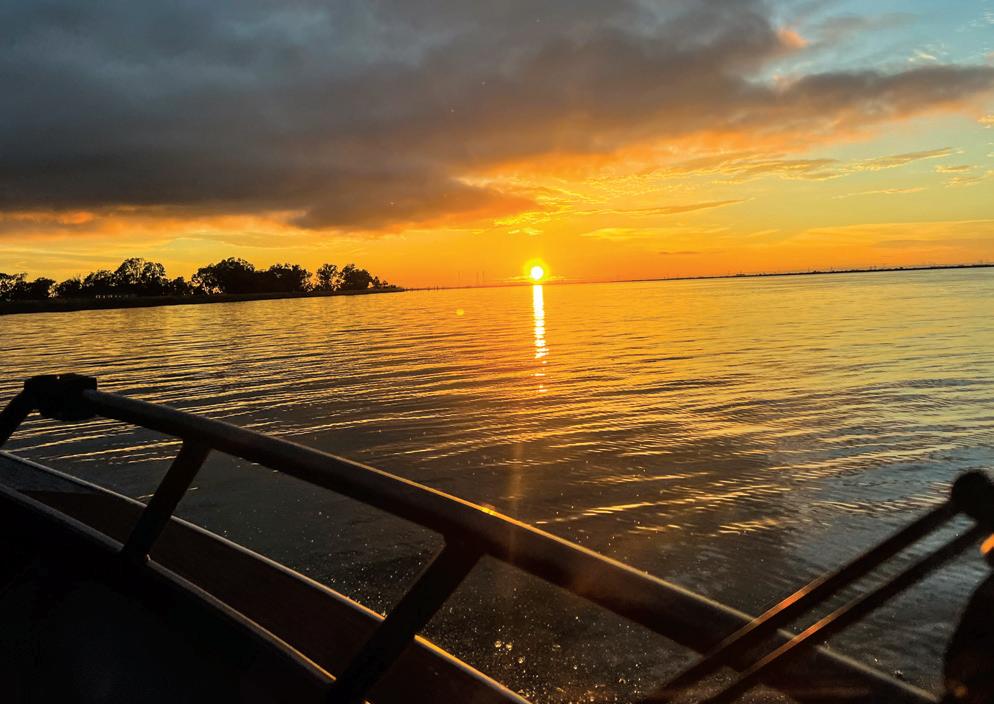
“Once the water reaches the mid50s, the bite should be really good. As long as the water is clean and warming up, the fish will start biting. April and May can be amazing. In a typical year, there will still be a good number of fish to be caught all the way up until June.”
The affable Delta guide is optimistic that this season’s run will be good.
“There should be a lot of fish pushing up from the bay,” Soo Hoo said. “If history tells us anything, the last really big rain year we had, the fishing was amazing.”
He expects the areas around Sherman Lake and Broad Slough to be among the first locations to hold fish. Decker Island and the West Bank on


the Sacramento River are sure to have fish as well. On the San Joaquin River side, the fish will work their way up to the Antioch Bridge, to the mouth of Three Mile Slough and upriver to Prisoner’s Point and beyond.







One of the things that makes fishing for stripers so popular is that they can be caught on a variety of techniques and a wide array of baits. From soaking cut bait to casting with artificials, there truly is something for every angler. Soo Hoo is an incredibly skilled guide and his specialty is light tackle fishing.

“There’s nothing more fun than catching stripers on light tackle,” he said. “Drifting with live jumbo minnows puts a lot of fish in the boat. At other times when the wind is up, we will troll minnow plugs and when the fish get into big schools, we may spoon for them as well. When we get on a good school of fish, it’s

not uncommon to have multiple hook-ups – doubles, triples and even quadruples. It can be frantic, a little chaotic and a lot of fun for sure.”
It’s all about the timing and being in the right place when it comes to a successful striper outing.
“Knowing when and where to be is crucial. It’s all about reading the water and understanding the current and the tide; you get little bite windows,” Soo Hoo explained. “Last year another fisherman came up to me at the dock and said, ’We see you out there fishing all the time and you’re catching fish. We know because we see your net going and every time we stop near you, you just leave. Why is that?’ I told him that I leave because I have somewhere better to be where I can catch a lot more fish.”
If you are looking for the opportunity to get in on some fastpaced striper fishing action, make sure to head out to the Delta this spring. It’s a bite that you will not want to miss. CS



Being a trout fishing guide in Northern California, I have the opportunity to talk with a lot of cold-water anglers over the course of the year. One of the subjects which pops up regularly is kokanee fishing.
A substantial percentage of my anglers are interested in kokanee, but they’ve never caught one. They’d like to give kokanee fishing a try, but they don’t know how to get started and they have lots of questions.
They ask things like, “What are kokanee?” “How do I catch kokanee?” “Do I need electric downriggers to fish for kokanee?” “Don’t kokanee live in really deep water?” “Do I need a lot of special gear to catch kokanee?”
I figure if my clients are curious about kokanee fishing, a good number of California Sportsman readers are likely in the same boat, so let’s take a deep dive into the world of kokanee fishing.

Kokanee are landlocked sockeye –Oncorhynchus nerka, if you want to be formal – which are an ocean-going salmon species that was once more common along the northern west coast of North America. These days, runs in the Lower 48 are struggling, while strong fisheries for them still exist in Alaska and Canada.
Like other species of salmon,
most sockeye spawn in rivers and then their progeny, after rearing in a lake for a period of time, travel to the ocean to feed and grow for a couple years before ultimately returning to their native river to spawn and die. Unlike most other species of salmon, sockeye are not predatory in the sense of chasing down and consuming baitfish. They are limnetic feeders; basically, they move up and down in the water column seeking and feeding on concentrations of zooplankton.
Through stocking programs, their landocked form, kokanee, are now found in lakes all over the West Coast and Rocky Mountain regions. There is even a lake in North Carolina with a population of kokanee.
While most kokanee spawn in their home lake’s tributaries, just like their seafaring kin, a small percentage successfully spawn on windblown lake shores where there is enough water movement to keep the eggs oxygenated and free of silt.

The big knock on kokanee is their size. In most lakes they simply don’t get very big. Having said that, ounce for ounce, a kokanee will generally outfight a trout and they are exceptionally strong and acrobatic.
Kokanee size is dictated by the amount of forage in a lake and the number of fish living within said lake. Getting kokanee populations properly dialed in can make fishery managers tear out their collective hair.
If a lake has too many of the salmon, they tend to get stunted, and anglers don’t like fishing for dinky kokanee. On the other hand, if there is only a small number of salmon within a lake, they will grow very large, but finding and hooking one will be difficult. The trick is finding the perfect balance between enough salmon to find and catch, and not so many that the fish become stunted.
My personal criterion for kokanee is 13 inches. Fish 13 inches and bigger have enough mass and strength to

Hoochies are outstanding kokanee lures when teamed with dodgers. You’ll want to run your hoochie two to three dodger lengths behind the blade on a double-hook rig to maximize its action. (CAL KELLOGG)

put up a thrilling fight. If the fish in a given lake average under 13 inches, I’ll typically pass on targeting them, preferring to do something more exciting – like raking leaves or watching paint dry.
The fight a decent-sized kokanee puts up is only part of the attraction of catching them. Kokanee offer exceptional table fare. Ask a native Alaskan what type of salmon they prefer to eat, and the answer is sockeye most of the time.
Kokanee offer bright-red, finetextured sweet meat. You can fry, barbecue, bake or smoke them, and the results are typically amazing.
If you are just starting out, the very best time to target kokanee is during the spring – say, in April and May. Kokanee prefer cold water, so in the middle of a hot summer at a lowelevation lake, you may have to go
down 60 or more feet to hook up.
While reaching into the depths with a downrigger offers a certain type of satisfaction, it’s not my favorite thing to do. I much prefer targeting fish near the top of the water column – say, in the top 20 feet – and that’s exactly where you’ll find early-season kokanee.
Before you set out on your first kokanee fishing adventure, do a little research and identify a lake or two in your region that offers decent-sized fish, and then you can plan your trip. There is no sense in chasing dinks when you could be battling high-flying 14- to 16-inchers!

Last spring, I caught dozens of fat kokanee from my kayak, and with the exception of a trip in early June, I got most of my fish on topline and hybrid leadcore rigs; no downrigger required!
You’ve probably never heard of a hybrid leadcore rig; that’s because I
was one of the guys who perfected the rig and I coined the term. I won’t explain it here, but if you are interested in running a light, responsive leadcore rig, type “hybrid leadcore rig” into a Google search and a long list of videos with me explaining what the rig is and how to set it up will fill your screen. Or see the January issue of this magazine.
Light, soft rods are the way to go for kokanee fishing. If you troll for trout already, run with whatever rods you currently use.
End tackle is where things get fun when it comes to kokanee fishing. To new anglers I often describe kokanee fishing as crappie fishing for coldwater trollers, which means the fish are typically small, feisty, great to eat and you get to play with a bunch of colorful lures when targeting them.
With so many lure and dodger
choices in the kokanee fishing world, it’s easy to go overboard. Indeed, if you become a kokanee junky, you will accumulate mountains of dodgers and lures, but you don’t really need a ton of gear to get started.

As I said above, kokanee are not predators in the sense of running down a minnow, so you aren’t going to pull lures to spark a predatory response. Instead, you are trying to draw strikes out of a sense of aggression or curiosity. I’m not really sure which, since I’ve yet to catch a kokanee willing to talk about motivation.
Kokanee can be very color sensitive. A color that captures their curiosity or triggers their aggression now may quit working in an hour, so you’ll have to change colors to draw more strikes. The same is true in terms of the vibration and flash created by your lures, dodgers and flashers.
When starting out, you’ll need three basic lures: snelled spinners, hoochies and small spoons. You’ll need these lures in a few basic colors
such as orange, pink, green, white and metallics like chrome and gold.
There are times when you can catch kokanee with naked lures, but you’ll be best served running with a dodger or flasher about 90 percent of the time. When using dodgers, you’ll want your lure two to three dodger lengths behind the blade.
Many kokanee guys stopped using
flashers long ago and, truth be told, I don’t run the big strings of metal blades anymore either, but I still use flashers. I like modern low-drag flashers. Mack’s Lure’s mylar Hot Wings-style flashers are excellent, as are my Turbo Flashers (Google Turbo Flasher). Both of these products put out a ton of flash and vibration without adding fight-deadening drag to your rigs.

Pay attention; in the next few lines I’m going to break down the basic progression of kokanee fishing in terms of flash and vibration.
Early in the morning, when the light level is low, start out with maximum flash and vibration. Color is a moving target you’ll have to play with, but first thing in the morning is the time to run your spinners and 4-inch chrome dodgers.
Very likely this flashy and loud gear will produce strikes for a while, but as the sun climbs your bites will taper off. The fish have stopped biting because your gear is now scaring them with too much flash and vibration.
As the sun climbs in the sky, your offerings should get quieter and more subtle. Get the chrome out of your spread and break out your small dodgers and small flashers.



You may have to shelve the spinners for spoons and hoochies.
Here is my kokanee philosophy in a nutshell: When the kokanee are aggressive early, shock them with big flash and big vibration. As the kokanee become shy with rising light levels, it’s time to break out your subtle presentations.
Lures tipped with corn outperform lures without corn by a huge margin. First, make sure it’s legal to use corn at the lake you intend to fish. Here in NorCal, it’s legal at almost all kokanee lakes, but check anyway. I don’t want to get anyone a ticket.

Back to the corn. Why do you need it? For starters, it is a great medium for holding scent, and scent can be a key part of drawing strikes. Second, a piece of corn gives a following kokanee a nice target to strike right there on the hook. If they attack your
corn, they usually get hooked.
I could write several thousand words on shoepeg corn (the preferred corn type for kokanee fishing) and how to cure, dye and scent the corn. Luckily for you, this is all graduatelevel stuff. Starting out, just pick up a few bottles of Pautzke Fire Corn. It’s ready to go out of the bottle and comes in a range of colors. Natural and pink are must-have colors; beyond that go with whatever tickles your fishing bone.
Let’s talk about landing kokanee. Kokanee are wicked little fighters and they really like to jump. If the bite is good and you don’t care about losing a few fish, keep your rod tip high and enjoy the show.
If, however, you want to put the fish you hook into the smoker, you’ll be best served keeping them beneath the surface where the water pressure helps keep your hook attached to their mouth.
You accomplish this by dropping the rod tip and reeling anytime your fish attempts to jump or thrash on the surface. When they go skyward, simply dip your rod tip and crank the reel. This will almost always cause them to dive back below the surface of the water, and your hook-to-land ratio will increase substantially.
Finally, you never want to go kokanee fishing without a cooler for your catch since they offer such amazing table fare. When I catch a kokanee I’m going to keep, I like to rip their gills without dispatching them and put them on ice immediately. They bleed out quickly, getting the blood out of the meat, and the ice keeps them firm and fresh! CS
Editor’s note: Cal Kellogg is a longtime Northern California outdoors writer. Subscribe to his YouTube channel Fish Hunt Shoot Productions at youtube.com/ user/KelloggOutdoors.





The lightest 200-hp four stroke on the market
The lightest 200-hp four stroke on the market

2.8L displacement and Variable Camshaft Timing give it the best power-to-weight ratio of any 200-hp four stroke
2.8L displacement and Variable Camshaft Timing give it the best power-to-weight ratio of any 200-hp four stroke
Nearly 120 pounds lighter than our four-stroke V6 F200
Nearly 120 pounds lighter than our four-stroke V6 F200
ALL-NEW F200 IN-LINE FOUR.



Show the water who’s boss with the new F200 In-Line Four. Incredibly light, responsive and fuel efficient, it serves up plenty of muscle to handily propel a variety of boats. On top of that, its 50-amp alternator offers the power to add a range of electronics, and its 26-inch mounting centers and compatibility with either mechanical or digital controls give you the flexibility to easily upgrade your outboard or rigging. Experience legendary Yamaha reliability and the freedom of forward thinking, with the all-new F200 In-Line Four.
Show the water who’s boss with the new F200 In-Line Four. Incredibly light, responsive and fuel efficient, it serves up plenty of muscle to handily propel a variety of boats. On top of that, its 50-amp alternator offers the power to add a range of electronics, and its 26-inch mounting centers and compatibility with either mechanical or digital controls give you the flexibility to easily upgrade your outboard or rigging. Experience legendary Yamaha reliability and the freedom of forward thinking, with the all-new F200 In-Line Four.


Most bass fishermen give up on winter or early prespawn fishing because it can be a real test of wills and stamina. It can be cold, rainy and just downright miserable to fish in the winter and
spring months, but because the weather in Southern California is so unpredictable, it could also be the most beautiful weather any day.
Winter fishing can slide seamlessly into spring. You should always expect the unexpected and be ready to react with the proper approach for the bass.
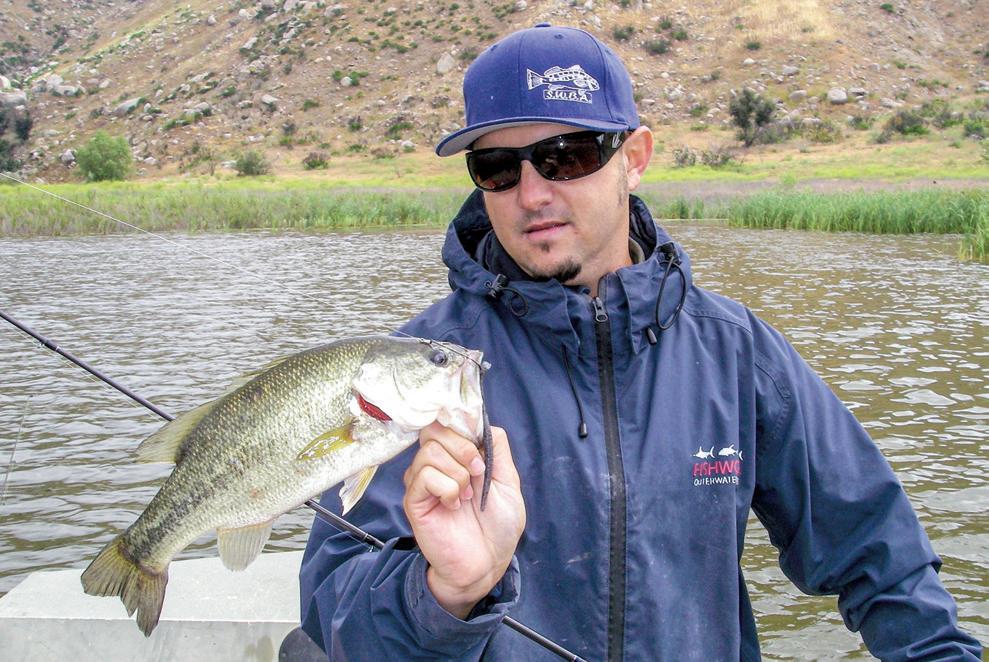
LATE WINTER AND EARLY SPRING ARE TOUGH, BUT THAT DOESN’T MEAN THERE AREN’T LESSONS TO LEARN, FISH TO CATCH
The warmer the weather, the warmer the lake’s water temperatures, and the more active the largemouth will be. We all know that as the waters cool in the winter, the bass become more lethargic and feed less. All it takes is for the water of a lake to
start to warm again and the entire bass population will become more active. The largemouth do not have calendars, so no matter the date, the warming waters will trigger their instincts to start their prespawn or even their spawn.

It could very well occur in March –say, we’re having an unusually warm winter – and some lakes’ bass will start to spawn. Males start roaming the banks and females move up to nearby points at the ready for their respective mate.
You could virtually miss the spawn if you don’t start thinking about it early enough. That is why, as I mentioned, most diehard bass fishermen don’t ever stop fishing if they don’t have to.
If you do not understand the life cycle of largemouth, then you need to read more magazines or online articles like this one, watch videos and visit all the seminars you can. But most of all, get out on the water year-round; that way you can better understand the cycle of your favorite lake. The better you understand where the bass have gone – at any time of the year – the better fisherman you will be.
Those breaking fish you were chasing only a couple months ago will just be hunting the same schooled-up shad or baitfish, but a little deeper. They are not gone; just a little harder to find and fish for. This is where your electronics come in. If you don’t have electronics, then you need to get something. If you are traditionally a rental-boat fisherman, then invest in a portable unit. It is one of the best things you can buy and will make a world of difference.
Remember the life cycle of the largemouth? Different times of year, different depths. If you can’t tell how deep the water is, then you may be fishing where there are no bass.
Another variable to remember in this
transitional time is that most lakes in Southern California plant trout during the cooler months to draw in another group of fishermen. This also bodes well for the largemouth fishermen, because the bass love to treat themselves to these tasty morsels. Invest in some imitation trout lures and you will stand a chance of scoring a giant while biding your time in winter ahead of the prespawn period.
Where should you bass fish this winter and spring? The answer has to be your favorite lake. For most bass anglers, they usually have a favorite lake where they catch the most fish, know several reliable spots, and just plain feel the most confident to fish. This should be your starting point, because you have confidence and a built-in knowledge of the lake that you can advance on and add to your
*At participating dealers only. Qualifying retail customers may receive instant savings off the selling price of a Honda powered boat package or Honda Marine engine(s) sold for repower. This promotion is limited to new Honda Marine BF40-BF115 and BF150 outboard engines, 2018 and newer models, sold and delivered between January 2, 2023 thru March 31, 2023 and registered by April 11, 2023 and in accordance with American Honda Motor Co., Inc.’s sales registration requirements for this promotion. Only Honda Marine outboard engines sold for personal use qualify for this promotion. Fleet, commercial & government sales are ineligible. Engines sold under special pricing/promotions including (but not limited to) demo and tournament fi sherman engines are also excluded. Honda Marine reserves the right to modify, amend, cancel or revoke, in whole or in part, this promotion at any time without prior notice. Always wear a personal fl otation device while boating and read your owner’s manual. All Honda outboards meet EPA and CARB emission levels. © 2023 American Honda Motor Co., Inc.

past experiences.
If your lake closes for the winter –many in the Southland do shut down – then fish right up to the closure and file away in your mind where the lake left off when it closed.
You could also move to one of the other lakes in your area that stays open. There are still bass there to find, and if you spend enough time on the lake, you will discover where you can fish at a time of year when you might be at home watching football instead.
Remember, once you have spent some time experimenting and examining the bass at your favorite lake, then you should be able to plot out an attack on any lake. Timing, water temperature and weather all

make a difference, and once mastered, you will see that finding the bass at any lake can be much easier throughout every season.
Late winter and springtime can bring a great spinnerbait and crankbait bass bite, though you would think a lake would be too cold in the winter for that, even though the weather is actually mild. But all it takes is a warming trend into spring and the fish go into their prespawn mode. In a lake with a lot of rock cover, those rocky points can help warm the water.
If the water is up at a lake, then brush and rock will litter every shoreline. The fish really gravitate to
the brush when water rises and it can be real fun going in after them. Long lake points can hold larger fish, but will hold all sizes in late winter and spring. Drop shot these areas with small worms in crawdad colors.
Start out with spinnerbaits around shoreline brush. Don’t be afraid to throw past and bring it right through the middle of it. Crankbaits will slam fish as well. The bass want crawdads this time of year and you can crank the rocky points with crawdad colors, but remember to work the beaches between them too. Grind that crankbait down till you hit bottom, then go to a slower stop-and-go retrieve, bouncing it off anything down there. It looks just like a crawdad scurrying along the bottom kicking up silt.
Spooning in winter and spring can produce fish, plus trout lures can be effective, since most lakes also stock trout through the colder months.
You can transition into the early prespawn with spinnerbaits and jigs. Carolina-rigged craw-like creatures also do very well this time of year. Flukes or anything shad-like can do well once the prespawn loads the shallows with males searching for nests. Main lake points will hold larger females that need crawdads for nutrients for spawning and will attack jigs in those patterns.
If a storm keeps you stuck at home in winter, take that time to prepare your tackle. This is the time to rebuild or clean and oil your reels and load them up with new line, as well as straighten out all your tackle boxes. You know you are as bad as I am – just throwing things into whatever rod locker is closest. Organizing your tackle will make you a more efficient angler.
Prespawn bass fishing success won’t come fast – winter can be a brutal time to fish – but as you start to catch fish when you never thought you would, your confidence will grow with your knowledge. Learn to fish all year and you will be able to take on any lake under any conditions. CS
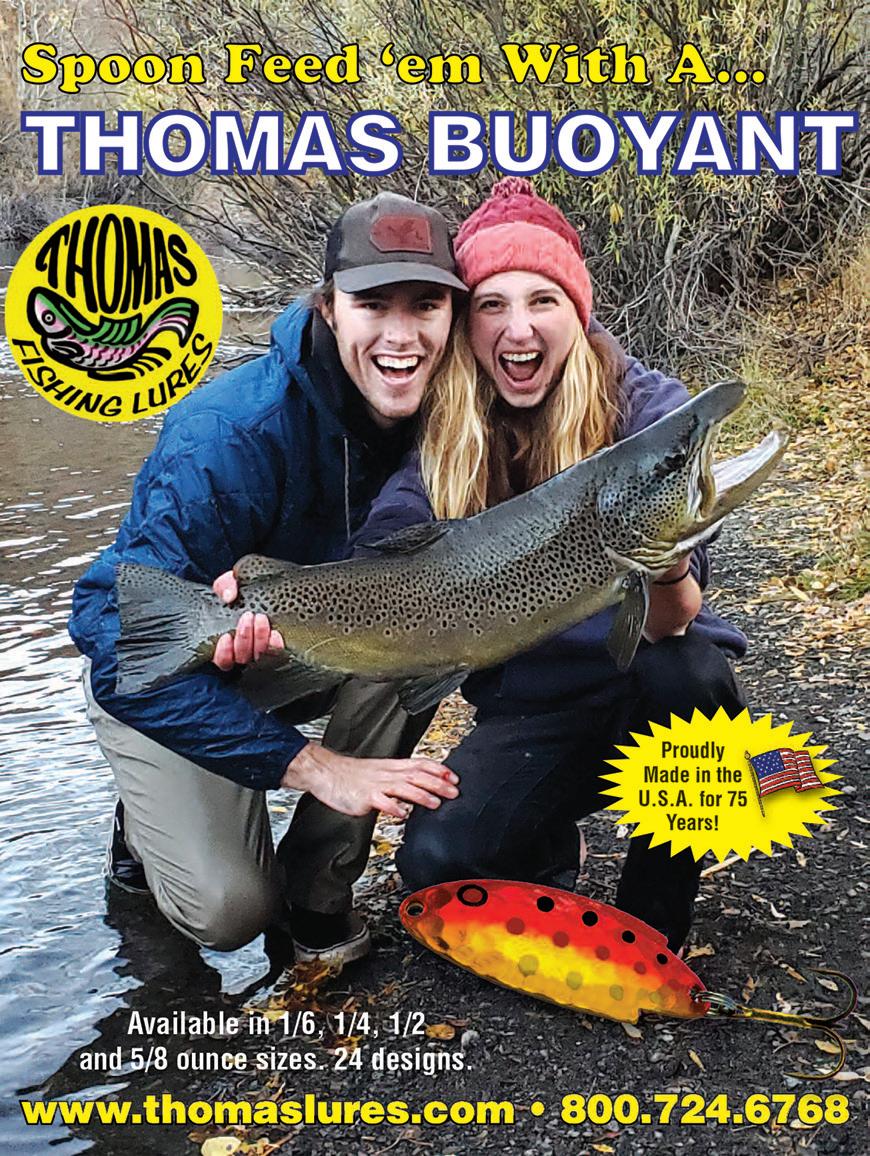

PRIVATE LAND MIGHT SEEM LIKE THE ONLY PLACE TO HARVEST A TOM, BUT NATIONAL FORESTS AND OTHER OPEN LANDS ARE ALSO PRODUCTIVE – HERE’S HOW TO FIND SUCCESS ON THEM!
By Cal KelloggI’m a certified self-taught turkey hunting junky. Fall hunting is fun, but the spring season is downright addictive. I’ve killed more spring gobblers than I can remember – well over 60 – and all of them but two were taken on public land.
I’ve killed some jakes, a lot of
2-year-olds and several 3-yearolds with 10-plus-inch beards and weighing up to and beyond 20 pounds. A 20-pound Rio Grande living on public land is a monster.
My biggest gobbler to date was killed a few seasons back. He registered 22.8 pounds with his internal organs removed. He was an elusive old veteran – roosting and

traveling with a harem of hens. More about him later.
Some of the following advice runs contrary to the tips given by pro hunters with access to private land with strong turkey populations.
CALLING
Less is more when it comes to harvesting mature birds on public
land, so don’t overcall! It’s fun to make a gobbler fire off repeatedly, but that’s not natural. Secondly, on public land all those gobbles can attract another hunter.
Remember, once a gobbler responds to your hen noises you can assume two things. He thinks you’re another turkey, and he has a very good idea about exactly where you are. Light calling plays on his insecurities. You want him to be excited and anxious, so play hard to get.
You don’t need a big array of calls. I hunt with a diaphragm and a friction call. Mastering a diaphragm is a must because it’s a call you can use without the aid of your hands. Your second call should be some sort of friction call. Some guys like a box call, while others use a pot-style friction call.
I’ve used both, but for ease of carrying it’s hard to beat the pot call. My favorites have a glass or Plexiglas striking surface, but ceramic and slate versions work great too.
Learn to purr and yelp. You don’t need to be an expert caller to kill spring
It doesn’t take a wide selection of calls and gear for a successful spring turkey hunt. Here we see the cornerstones of Kellogg’s gear: a friction call, a mouth call and a single hen decoy. Combining these tools with head-to-toe camo and his Remington 870, the author has harvested dozens of public-land gobblers. (CAL KELLOGG)

gobblers. All hens sound different. Practice the fly-down sequences with the thigh slapping I used in the hunt described in the sidebar story (page 42). I’ve killed dozens of birds off the roost with my fly-down sequence.
You will need a shock call to locate
turkeys later in the day if you don’t kill a bird off the roost. I prefer a crow call or a call that simulates the scream of a red-tailed hawk.
A single hen decoy is a must. The benefits of a decoy are multifaceted. First, they take the focus off you. Second, they can bring a reluctant turkey in from a distance. Third, they can put the gobbler into a good position for a shot, and finally, when dealing with a henned-up bird, they can be used to close the deal with zero calling.
The 22.8-pound bird I harvested was roosted on public land with a bunch of hens. As soon as they flew down, the whole flock would move onto private property and mingle with a bunch of chickens on a foothill hobby farm.

The big boy would gobble and gobble, but he wouldn’t leave his hens. I figured out where the birds landed off the roost. I set up my hen decoy well before daylight and wrapped a red bandana around its neck. I wanted Mr. Big to think another gobbler was moving in on his ladies.
Long story shorter, when the birds started flying down, hens were hitting the ground all around

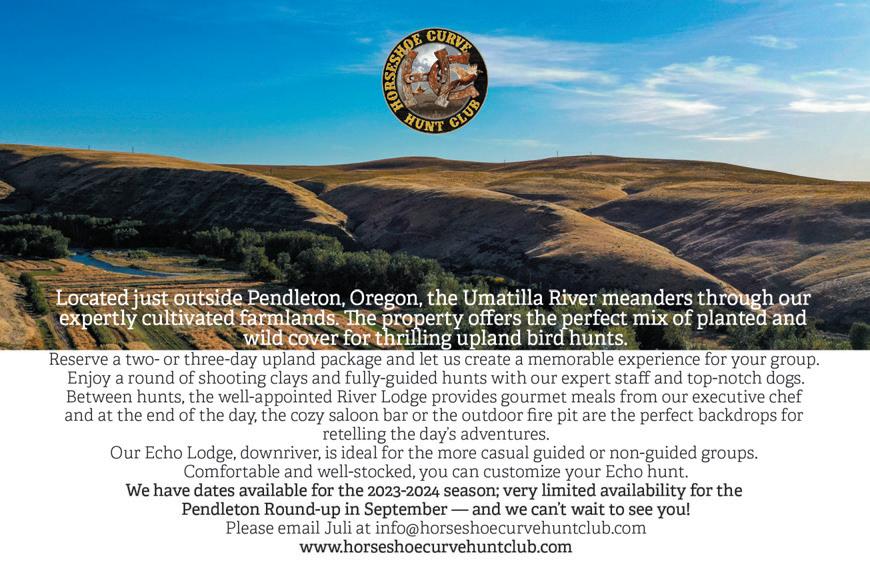
Let me tell you the story of my last spring gobbler, a hunt in which I used many of the tips shared in this issue.
While walking my dog in early March through a patch of dense pine woods at about 4,000 feet in elevation, I heard a gobble. It was a very unlikely spot. It was higher in elevation than I typically find spring turkeys. There were some oak trees, but few meadows, openings or grassy areas.
A week later, once again while walking Lucy, I saw the gobbler. He was big, black and had a thick rope-like beard hanging from his chest.
I was pumped – I had a legal bird located in an area with zero hunting pressure – but Mother Nature tossed me a curve. A few days before the season opener the temperature dropped and several inches of snow fell on my hunting area.

I’d hunted with a dusting of snow be-
fore, but never in deep snow. The snow and the 20-plus-degree temperature drop shook my confidence and I worried my big gobbler might have moved down to a lower elevation where there was less snow. Yet the spring season is long and I had plenty of time to hunt, so I stuck with my opening-day plan.
I slipped into the woods a good hour before dawn broke and hiked to the area where I’d seen the bird. I backed up to a big pine and waited in silence. Finally, darkness gave way to faint milky light and I heard the first peeps from songbirds tucked in the fir trees around me.
More time passed. In my younger days I would have sounded off with some sort of shock call, but I opted to wait. Maybe 10 minutes later the gobbler fired off to the east of me in a hollow below my position.
Instantly, I was on the move, deliberately closing the distance between myself and the bird. He didn’t gobble
continuously like a jake, but he gobbled often enough for me to roughly pinpoint his position.
When I felt I was 75 yards from the bird and still above him, I paused to set up. The woods were thick, but there were a couple runways I figured had been created by logging activity. Fifteen yards in front of me there was a 4-foot-high hump. I slid the decoy out of my vest and placed it atop the hump. A clump of small fir trees would block it from view on one side, but from the other side I figured it could be seen from 40 yards away.
I spread a garbage bag on the snow to keep my backside dry and settled in against a tree with the decoy off my left shoulder and the 870 Express pump resting across my thighs pointed toward the decoy.
I was comfortable, camouflaged and completely hidden; it was time to call. I slid a friction call out of my vest. I already had a diaphragm call in my mouth. I made two light purrs and a single sleepy yelp on the friction call.
The gobbler fired off instantly. I went silent. He upped the ante and gobbled a couple more times. I waited for a few minutes and made three yelps a little louder. He responded with a double gobble. I had him. He was convinced I was a roosted hen, and he knew almost exactly where I was. I made no more sounds for a long while.
Before turkeys fly to the ground, they start making more sounds and get quite agitated. When the gobbler started gobbling more frequently and yelping, I knew he was preparing to fly down. I did some yelping on the friction call and threw in some yelps with the diaphragm. I increased the tempo of the calling for about a minute and then beat my palm on my thigh several times in quick succession. I was mimicking the sound of two hens flying off the roost.
The gobbler was going nuts and then he went quiet. He was out of the tree. Now the waiting commenced. I eased the gun up on my knee ready to shoot.
For a painfully long time nothing happened and then I heard a barely audible swishing sound. What the heck was that? Swish, swish, stop ... Swish ...
I realized it was the gobbler walking on the snow. More time passed. More swishing, but louder now. Suddenly there
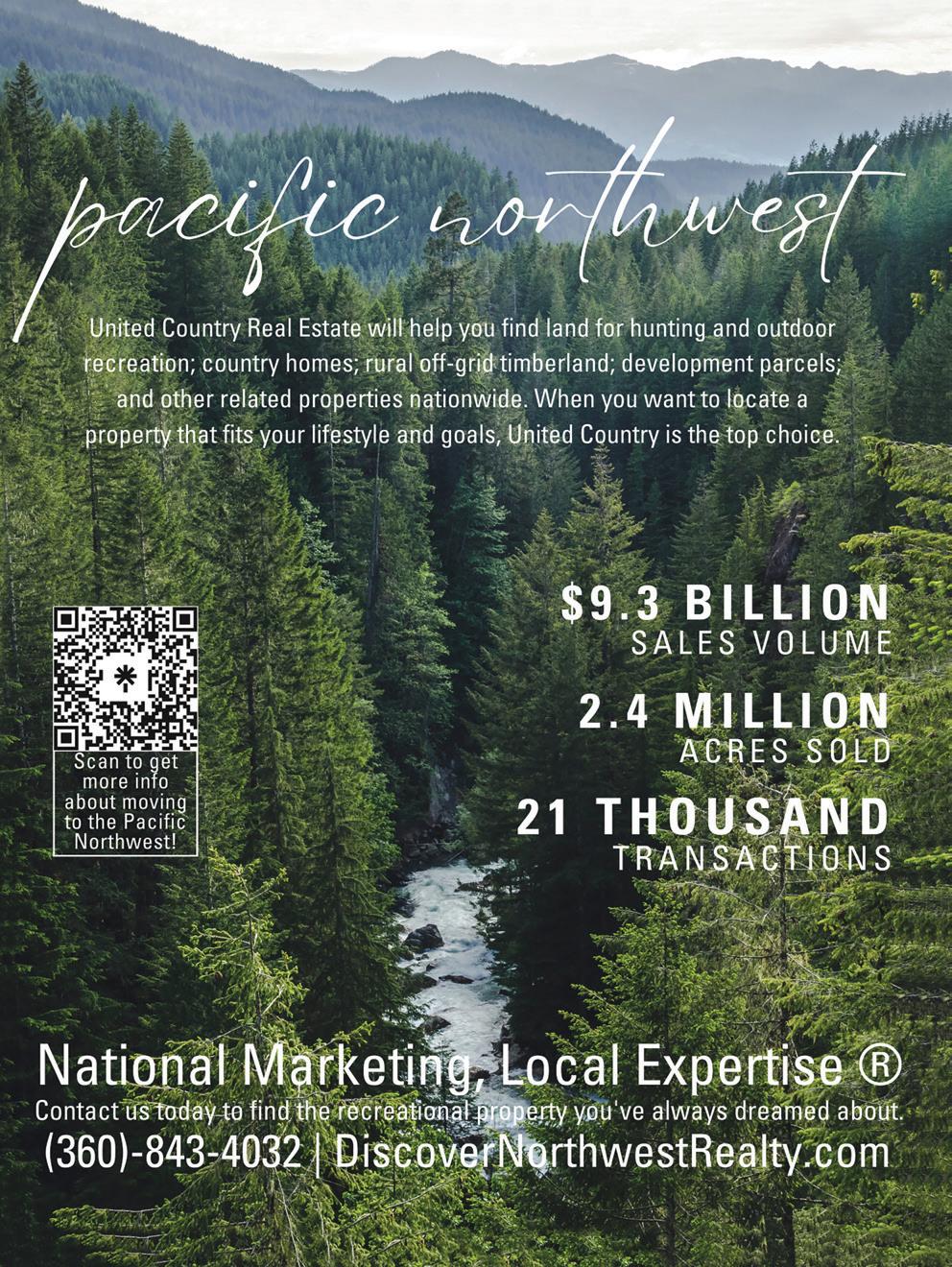
was a rustling sound right behind me and I heard the peculiar hum of a gobbler drumming. The turkey had puffed into a full strut directly behind me next to the tree I was leaning against.
A gobble exploded the silence. My heart was in my throat. I sat statue-still, as I had no other option. He was looking for the hens but couldn’t find them, and apparently he hadn’t seen the decoy.
A beat later I heard him fold his tail back down and he slowly walked away. When I could no longer hear his footsteps, I made two very light yelps with the mouth call, and he gobbled instantly. He was on his way back.
The first thing I saw was his head bobbing around; then he came into view. He was big, beautiful and hyperalert. He saw the decoy now but acted confused. The gobbler was out in front of me off my right shoulder. He was within easy range, but at an awkward angle. I’d have to move significantly to shift the shotgun muzzle in his direction.
The bird walked forward with caution. When he was 20 feet from the decoy he went to half strut, stared at the decoy for a beat and then slowly came to full strut. I could tell from his body language there was something about the decoy he didn’t like.
I feared he was going to fold back up and split. The angle was better, but to get on him I would have to move and he would see me when I did. I hoped he would fold back up and hesitate for an instant, but that would be the best-case scenario. I had to be ready to shoot fast.
I dropped my knee, brought the gun up and moved the muzzle right. The gobbler was about 15 yards out. He pulled in his feathers and lunged forward while beating his wings. Muscle memory took over. I had tunnel vision now and time was moving slowly. I took an extra nanosecond for a sure shot. The bird had just cleared the snow.
He was 2 feet in the air, accelerating and climbing. The front sight flashed past his head and the gun roared. The big bird flipped and hit the snow with a heavy thump. I could see his feet clawing at the air; the gobbler was dead before he hit the snow.
I’d done everything right and my reward was a 21-pound public-land gobbler with a 10¾-inch beard! CK
me. One took up a position about a yard off my right elbow. When the gobbler spotted the decoy, he came in on the run. He stopped statue-still to challenge the “new” tom 20 yards from the muzzle of my Remington. That was his last mistake!

The first hour of daylight and the period between noon and 3 p.m. have been the best times for me. Here’s why: If you can find a bird on the roost and move in tight, you can often harvest the bird within an hour of him hitting the ground.
Once the post-dawn window closes, gobblers typically move to hens. Most mature birds are in the company of hens from just after flydown until late morning. A hennedup gobbler will sound off to your calls with enthusiasm, but calling a gobbler away from hens is nearly impossible. The hens don’t want to lose their mate, so when they hear your calls, they will generally lead the tom away.
The hens go to nest to tend eggs or to lay a new egg late in the morning. A gobbler you find henned up and unhuntable at 9 will often be alone and willing to respond to calls at noon or later.
You can often get an afternoon gobbler to fire off a shock call, but don’t be surprised if he won’t answer the hen noises. That’s OK, as he will still come in, but many times he’ll slip in silently. In this situation I like to deploy a decoy and make a couple light yelps and purrs every five to 10 minutes.
To kill silent afternoon toms, you must remain vigilant and sit very still. I’ve set up within 100 yards of toms in the afternoon and it’s still taken them a full hour to come within range, so this is why I say patience matters.
Scouting for roosted birds in the evening is a very effective tactic. General scouting can be effective, but you don’t want to scout before the first week of March. As winter gives

way to spring, winter turkey flocks break up and the turkeys disperse.
Typically, the areas where I kill turkeys in late March and April were devoid of birds in January and February. This isn’t really a scouting tip, per se, but this is a good place to mention it. The hardest thing to deal with in the spring woods is other hunters. They call too much, spook the birds and make them develop lockjaw.
I strongly encourage you to seek out areas where hunting pressure is light. Hunters, especially beginners, want to hunt those classic rolling meadow areas at lower elevations. You’ll do better exploring higherelevation areas with steep canyons and dense vegetation. Yes, these areas hold fewer birds than lower regions, but you’ll have less competition and that is often the key to success.
There are all sorts of fancy turkey guns on the market, and I know guys who buy a new gun every year of two. Buying a new gun is fun, but I think it’s important to really know your gun. I’ve been using the same old Remington pump for 20 years.
I’ve experimented with different chokes and loads, and I’ve got it dialed in. It sports fiber optic sights for precise shooting at close targets. Remember to practice those close shots. You’ll want a tight choke to reach out with, but if you get a close opportunity, your pattern may only be a few inches in diameter. I missed a big tom once at 10 yards!
The best range for killing birds is from about 15 to 30 yards. I killed them out to 50 in my younger days, but now 40 or 45 yards is my max. Truthfully, if you can’t get within 40 yards of a gobbler in spring, you need to improve your woodsmanship and your setups.
My pet load for many years was a 3-inch shell throwing a payload of copper-plated No. 6 shot. When the lead ban came into play, I switched
to tungsten shot. I’ve found the tungsten to be dramatically better than lead.
Killing turkeys is all about hitting them multiple times in the head and neck. The more pellets you can launch, the easier it is to put pellets on target. The heavier-than-lead tungsten has allowed me to drop down to No. 7 shot. I shoot shells with a 2-ounce shot payload. There are significantly more pellets in 2 ounces of No. 7 shot as compared to
My final piece of advice is to always employ head-to-toe camo and sit still. Spring turkey hunting is a closerange sport and most of the time the gobbler knows exactly where you are. One bob of the head or twitch of your hand can blow the deal, so learn to sit still like a statue! CS


Our remote Alaskan fishing lodge is situated on the upper stretches of the beautiful Egegik River. You’ll watch some of Alaska’s most stunning sunrises, complete with a distant, active volcano. We are a fishing camp specializing in coho fishing, brown bear viewing, and flyout fishing adventures to even more remote destinations in the Last Frontier.
The Egegik River is touted by many experienced anglers as the best silver salmon stream in all of Alaska. Becharof Lodge On The Egegik River was the first fishing lodge to become established on the breathtaking Egegik River, and is less than a 5 minute boat ride from some of the best fishing holes on the entire river.




Included in your fishing trip:

• 5 days fishing/5 nights stay in camp
• Experienced, fully guided fishing.


• Comfortable cabins furnished with beds, cozy comforters & bedding.
• Home cooked meals, snacks, and nonalcoholic beverages.
Trips
$4,850per person
• Transportation from the lodge to prime fishing holes on the Egegik River.
• Freezing and vacuum sealing of your fish, up to 50 lbs., per angler.

As soon as I found turkeys lurking in the timber a couple seasons ago, I set eight trail cameras on that 1-mile-wide, nearly 3-mile-long ridge. I’d taken many turkeys from it over the years, but that spring marked the fewest toms I’d seen leading up to the season opener. That changed when I headed into the timber.

Not only did I reposition all my trail cameras inside the timber, I also spent hours scouting it. Due to thick cover, however, trail cameras proved more beneficial compared to what I saw, or failed to see, in person.

I run trail cams on video mode in order to capture sounds on the periphery of what’s in the frame and to study bird behavior – things you
can’t decipher from a still image. I use StealthCam’s DS4K Ultimate cameras; their video quality is tops, as is their ability to work in a range of year-round conditions.
What surprised me the most was the number of predators I caught on camera leading up to the season. One video clip captured three mature coyotes chasing turkeys, while another snippet caught four predator species on the same trail in one night.


While March celebrations traditionally bring corned beef to mind, corning wild game of any kind is a wonderful year-round addition to the table.

Corned venison and corned waterfowl may be recipes you’ve tried, and if you haven’t, you should. With spring season starting soon, try corning that wild turkey and you will not be disappointed. Corning game not only adds to the flavor and textures of meat, it offers a break from making any cooking decisions for three to 10 days.
Due to the preservatives in Morton’s Tender Quick seasoning or a pink salt cure, meat can brine for an extended period of time. This means you can cook up a bit of your quarry, toss some in the brine for the following week and freeze the rest. Use the breasts or the legs, wings and thighs
for this recipe that offers a wild game twist on a St. Patrick’s Day staple.
Two wild turkey breasts or the legs, wings and thighs from one turkey
¼ cup boiling water
6 cups ice-cold water
3 tablespoons Morton’s Tender Quick seasoning
2 tablespoons brown sugar
2 tablespoons pickling spices
1 tablespoon granulated garlic
1 tablespoon granulated onion
1 tablespoon black pepper
In a large brining container, mix dry ingredients with boiling water and stir to dissolve. Add ice-cold water and stir well. Add either two turkey breasts or the wings, legs and thighs of one turkey to the brine. Be sure all meat is submerged in the brine. Refrigerate three to 10 days.
Corned turkey breast can be smoked, grilled, sliced and pan fried, pressure cooked (high pressure 30 minutes) or slow cooked (three to five hours or until tender). Wild turkey wings, legs and thighs should be pressure cooked (high pressure 50 minutes) or slow cooked (five to six hours) until meat can be removed from bones easily.
Shred or slice corned wild turkey and serve in a traditional Reuben sandwich, fried into hash or served beside eggs (any style) for breakfast.

Editor’s note: For signed copies of Tiffany Haugen's popular book, Cooking Game Birds, send visit scotthaugen. com for this and other titles.

WhileSt. Patrick’s Day meals traditionally include corned beef, Tiffany Haugen uses wild turkey for a delicious twist on a classic dish. (TIFFANY HAUGEN)

With so much predator pressure, toms stuck to the timber for safety. Here, not only could they live in the shadows of towering trees, but the underbrush offered ideal cover, and the labyrinth of deer and elk trails made for easy travel.

Once you know toms are there, patterning their movement is the next step. If there’s one thing I’ve learned in all my years of turkey hunting throughout the West, it’s that toms travel much more in the timber compared to toms that stick to their strutting grounds, gobbling and waiting for hens to come to them.
Timber toms not only cover more ground, they’re quieter – not gobbling at every sound you throw out – and they’re leery. One mistake in a setup or calling can cost you, which is why patterning their movement is important so there’s no doubt as to where to start.
Timber toms cover a lot of ground. They’ll move to avoid predators, be it
through the air or on the ground. Also, food sources aren’t as localized inside the timber, meaning they have to cover ground to get more nutrients. Finally, toms cover a lot of ground checking openings and timbered fringes for hens they can potentially breed.
In order to find consistent success when hunting turkeys inside the timber, be mobile, but also be patient. Once toms are patterned working a specific ridge or draw, commit to setting up in an area where multiple game trails intersect or along trails they commonly travel. Setting up along timbered edges with a few nearby openings is also a good decision.
Timber-dwelling toms can be hunted all day, as shade offers concealment and cool temperatures, which encourages movement. If dry, the forest floor also provides prime dust bathing, something toms routinely do to cool off, clean themselves and delouse their
plumage. Setting up along trails connecting dust bathing locales to roosting sites and openings on the forest fringe can pay off.
Since toms can cover a lot of ground inside the timber, decide if you want to stay put and wait for them to come to you, or go on the move in search of birds. If scouting reveals toms moving along specific trails throughout the day, stay put, occasionally calling, letting the decoy do the work.
Once you know toms are in an area, search for hens. Regardless of predator numbers and forest cover, the goal of toms this time of year is to seek hens. Much of your scouting should be dedicated to locating as many hens as possible, for where there are hens, toms won’t be far away.
When calling timber toms, keep it simple and minimal. While toms can be vocal in the timber, early in the


season they’re often tight-lipped.
Once you get a gobble, be quiet for up to 15 minutes, then call again. If one call is working, say, a slate, stick with it and try to close the deal with that one call so as not to overstimulate these already edgy toms.

While aggressive calling can bring in eager jakes at any time, it can also put wise toms on alert, often to the point where they won’t approach. Hen yelps and purrs are sounds of choice in the timber; think subtle and calm chatter to lure alert toms.
If your early-season hunting area has a solid number of hens but high predator activity, head to the timber in search of toms. In early spring, wherever hens are, toms won’t be far off. You just might have to dive into the forest to find them. CS
Editor’s note: For signed copies of Scott Haugen’s popular book, Turkey Hunting The West: Strategies For All Levels, visit scotthaugen.com. Follow Scott on Instagram and Facebook.

















Iposted a number of pictures and a few video clips on my Instagram page of my pudelpointers, Echo and Kona, retrieving ducks this past season. But one video fetched a lot of questions, the most common being, “How’d ya get him to do that?”


What they were referring to was Kona retrieving a bag of burritos from over 500 yards away. Let me set the scene.
MY BUDDY AUSTIN CROWSON and I were duck hunting. Two minutes into the midday hunt, a nice pintail came in, which Austin shot. Then we didn’t see a duck for nearly three hours. We both got hungry, figuring we’d have been done with a limit of birds by now. But despite what our scouting efforts had revealed, the birds weren’t showing up as we’d hoped.
“I can call my girlfriend and see if she’ll run some lunch out to us,” Austin offered.
“That’d be great,” I replied, “and if she parks by my truck, I bet Kona will go get ’em for us!”
A half hour later, our burrito delivery showed up. Austin and I were in a pit blind, and the first time I tried sending Kona back, he wouldn’t push past the sheetwater separating us from our lunch. So I got out, heeled Kona and walked 100 yards to the side so there was a direct line between us and the food – with no water in the way. Kona sat by my left side, as he always does when I cast him out. I released him, and he was off.
Two hundred yards out, Kona stopped and looked back at me, as he always does on blind retrieves. I gave him the “back” signal and he sprinted back another 100 yards or so
before again pausing, looking to me for direction.
LET ME BACK UP even further. Before I sent Kona on the odd fetch request, I got him excited, like when we play in the backyard. He sensed I wasn’t being serious, and knew this was all in fun. His ears perked, his tail wagged and he got a prance in his step that only comes out when he’s having fun.
Don’t get me wrong, Kona has fun hunting, but hunting is business. When he’s hunting, Kona is focused and will sit from daylight till dark looking for and retrieving ducks, no matter how cold, wet or hungry he gets. He doesn’t like being touched or petted when hunting. He’s 100-percent focused. So this request was out of the ordinary, and he knew it.
Also, when Austin’s sweetheart called to let him know she was close

with lunch, he asked her to call to Kona once he headed her direction for the pickup. About 200 yards out, Kona’s pace slowed and his stature grew upright and alert. Even from 300 yards away I could read his body language, which said to me, “I’m still having fun, but not sure where I’m going or why, and this girl’s high voice sounds a lot like Mom!”
Then he kicked it into high gear and sprinted right up to her. They’d met before, and Kona loves her. I would not have sent him to a stranger.
By the time Kona reached the delivery point behind an old ranch house where my truck was parked, I was back in the blind. Once I saw Kona had the bag secure in his mouth, I gave him two beeps on his e-collar. This is the most important communication tool I have with my dogs, as it allows me to get their attention and give them directions via hand signals at amazing distances.
As soon as Kona got the two beeps on his e-collar – which means “come to me!” – he did, fast. Kona sprinted the entire distance, not slowing down one time. Kona’s head was held high the whole time. So was his tail. His body language exuded pleasure. He loved doing something new, something fun.
BUILDING A POSITIVE RELATIONSHIP with your gun dog allows you to accomplish amazing things. When I’m done writing this story, for instance, I’ll print it out in my downstairs office, roll it up with a red pen inside, give it to one of the dogs and have them deliver it to my wife, Tiffany, to proofread. When she’s done marking it up, she’ll have one of the dogs bring it back to me.

We live 50 yards from my folks, in the country. When they call and have something for us, we’ll often send the dogs to get it. It might be a piece of mail, a bag of small oranges or a box of tissues. Echo and Kona
both love retrieving anything new and unfamiliar. They even help with laundry delivery around the house, both upstairs and downstairs.

Such behavior shows how intelligent a good breed of gun dog can be, and that they thrive on change and the mental stimulation that comes with it. Now that hunting seasons are over, make it a point to have fun with your dog. Get them fetching and doing things they’ve never done. Make an obstacle course for them to run. Take them to new places so they can explore. Challenge them in ways you never have, and you’ll soon realize how smart our four-legged hunting companions really are, and how they thrive on mental challenges. You’ll also discover how much dogs just want to have fun with you. CS
Editor’s note: Scott Haugen is a full-time writer. See his puppy training videos and learn more about his many books at scotthaugen.com and follow him on Instagram and Facebook.

